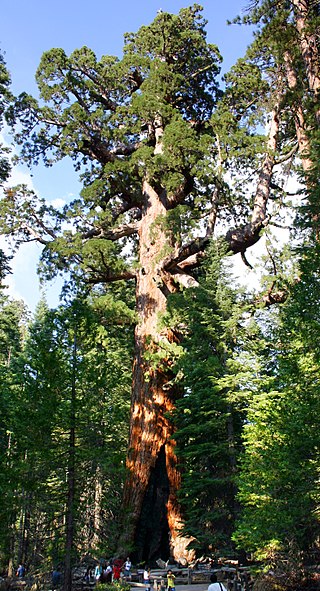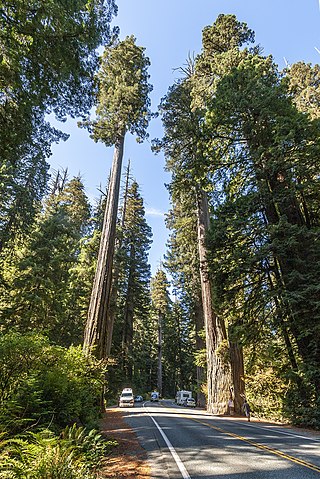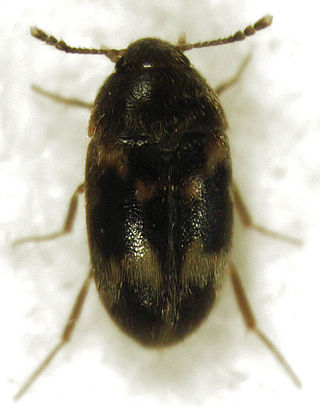
Sequoiadendron giganteum, also known as the giant sequoia, giant redwood or Sierra redwood is a coniferous tree, classified in the family Cupressaceae in the subfamily Sequoioideae. Giant sequoia specimens are the most massive trees on Earth. They occur naturally only in groves on the western slopes of the Sierra Nevada mountain range of California.

General Sherman is a giant sequoia tree located at an elevation of 2,109 m (6,919 ft) above sea level in the Giant Forest of Sequoia National Park in Tulare County, in the U.S. state of California. By volume, it is the largest known living single-stem tree on Earth.

Sequoia National Park is an American national park in the southern Sierra Nevada east of Visalia, California. The park was established on September 25, 1890, and today protects 404,064 acres of forested mountainous terrain. Encompassing a vertical relief of nearly 13,000 feet (4,000 m), the park contains the highest point in the contiguous United States, Mount Whitney, at 14,505 feet (4,421 m) above sea level. The park is south of, and contiguous with, Kings Canyon National Park; both parks are administered by the National Park Service together as Sequoia and Kings Canyon National Parks. UNESCO designated the areas as Sequoia-Kings Canyon Biosphere Reserve in 1976.

Calaveras Big Trees State Park is a state park of California, United States, preserving two groves of giant sequoia trees. It is located 4 miles (6.4 km) northeast of Arnold, California in the middle elevations of the Sierra Nevada. It has been a major tourist attraction since 1852, when the existence of the trees was first widely reported, and is considered the longest continuously operated tourist facility in California.

Calymmaderus nitidus is a species of beetle in the family Ptinidae.

Sequoia sempervirens is the sole living species of the genus Sequoia in the cypress family Cupressaceae. Common names include coast redwood, coastal redwood and California redwood. It is an evergreen, long-lived, monoecious tree living 1,200–2,200 years or more. This species includes the tallest living trees on Earth, reaching up to 115.9 m (380.1 ft) in height and up to 8.9 m (29 ft) in diameter at breast height. These trees are also among the longest-living organisms on Earth. Before commercial logging and clearing began by the 1850s, this massive tree occurred naturally in an estimated 810,000 ha along much of coastal California and the southwestern corner of coastal Oregon within the United States.

Poecilus is a genus of ground beetle native to the Afro-tropical, the Palearctic, the Near East, North Africa, and North America regions.

Sequoioideae, commonly referred to as redwoods, is a subfamily of coniferous trees within the family Cupressaceae. It includes the largest and tallest trees in the world. The subfamily achieved its maximum diversity during the Jurassic and Cretaceous periods.

Sequoia is a genus of redwood coniferous trees in the subfamily Sequoioideae of the family Cupressaceae. The only extant species of the genus is Sequoia sempervirens in the Northern California coastal forests ecoregion of Northern California and Southwestern Oregon in the United States. The two other genera in the subfamily Sequoioideae, Sequoiadendron and Metasequoia, are closely related to Sequoia. It includes the tallest trees, as well as the heaviest, in the world.

Xylotrechus a genus of longhorned beetles of the family Cerambycidae, containing some 200 described species.

Callidiini is a tribe of beetles in the subfamily Cerambycinae, containing the following genera:

Phymatodes is a genus of beetles in the family Cerambycidae, containing the following species:
Haplidus is a genus of beetles in the family Cerambycidae, containing the following species:
Phymatodes aeneus is a species of beetle in the family Cerambycidae. It was described by John Lawrence LeConte in 1854.
Phymatodes ater is a species of beetle in the family Cerambycidae. It was described by John Lawrence LeConte in 1884.
Phymatodes decussatus is a species of beetle in the family Cerambycidae. It was described by John Lawrence LeConte in 1857.

Litargus is a genus of hairy fungus beetles in the family Mycetophagidae. There are at least 20 described species in Litargus.

The SQF Complex fire—also called the SQF Lightning Complex or the Sequoia Lightning Complex—was a wildfire complex that burned in Tulare County in Central California in 2020. Comprising the Castle and Shotgun fires, it affected Sequoia National Forest and adjacent areas. Both fires began on August 19, 2020, and burned a combined total of 175,019 acres before the complex as a whole was declared 100 percent contained on January 7, 2021. In the course of the fires, 232 structures were destroyed. There were no fatalities.














